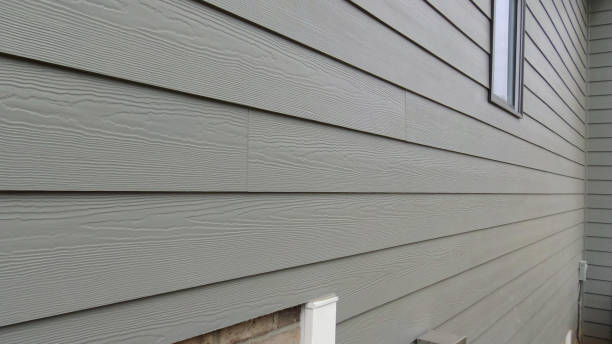As I stand in my own backyard, I can’t help but notice the subtle changes that time has etched into the once vibrant façade of my home. Your siding, which once boasted a rich, welcoming hue, now bears the marks of years gone by.
It’s a sight that many homeowners are familiar with—a gradual fading of the siding that once gleamed with youthful vigor. But what causes siding to fade? Is it simply the passage of time, or are there hidden culprits at play?
In this article, we embark on a journey to uncover the mysteries of siding fading. We’ll explore the various elements that contribute to this process. Along the way, we’ll share tips and insights gleaned from personal experiences and research, offering you a roadmap to not only understand the causes but also to take proactive steps in preserving the beauty of your siding.
Why Siding Fades Over Time
UV Rays
I recall a summer when I was repainting the siding of my childhood home. The afternoon sun beat down with an intensity that seemed to penetrate every pore of the wooden panels. That relentless UV exposure can be likened to a sort of slow dance – a dance that, over time, fades the vibrant colors we once chose with such care.
UV rays, the same ones that warm our skin on a beach day, are a leading cause of siding fading. They work insidiously, breaking down the pigments in the paint or finish and leave behind a muted, weathered facade.
Rain, Snow, and the Elements
Beyond the sun’s rays, Mother Nature has her own way of influencing the life of your siding. Rain, snow, sleet – they all play their part. Water can seep into cracks, causing the material to swell and contract with the changing weather. This continual expansion and contraction weaken the protective layers, making them more susceptible to fading.
Pollution
For those in urban areas, pollution is an often overlooked assailant. The fine particles and pollutants in the air settle on your siding, subtly altering its appearance. Over time, this layer of grime becomes more pronounced and dulls the once vibrant colors.
Choosing Fade-Resistant Materials
As I stand in the aisle of the home improvement store, faced with rows upon rows of siding options, I can’t help but be reminded of the importance of choosing the right material. It’s not just about aesthetics; it’s about durability, longevity, and the ability to stand strong against the inevitable march of time.
Fiber Cement
One material that has proven its mettle against fading is fiber cement. I’ve seen it weather the harshest of climates, emerging with colors still rich and vibrant. Composing a blend of cement, sand, and cellulose fibers, this material forms a sturdy barrier that’s highly resistant to UV rays.
Vinyl
Vinyl siding, with its sleek, modern appeal, has also made significant strides in the battle against fading. Many vinyl options now come with advanced coatings designed specifically to resist the sun’s relentless assault. These coatings act as a shield that help preserve the colors and patterns for years to come.
Brick and Stone
For those seeking a timeless, natural look, brick and stone siding offer a fade-resistant alternative. These materials don’t rely on surface finishes or coatings. Rather, their inherent color and texture is what endures through the years and makes them a wise investment for the long haul.
Composite Options
In recent years, composite materials have emerged as a versatile choice for siding. Comprising a blend of wood fibers and recycled plastics, composites can mimic the look of wood while offering enhanced resistance to fading and weathering. It’s a harmonious fusion of aesthetics and practicality.
How to Shield Your Siding from Fading
As I gaze at the siding that has weathered storms and seasons alongside me, I’m reminded of the importance of regular upkeep. It’s a ritual that not only preserves the visual appeal but also safeguards the very integrity of your home.
Cleaning and Clearing
When it comes to caring for your siding, a mixture of mild soap and water, applied with a soft brush or a pressure washer on low setting, can work wonders. It’s like a refreshing shower for your siding – one that washes away the accumulated dust, dirt, and pollutants.
Inspection
Once cleaned, take a closer look at your siding. Check for any signs of wear and tear and pay special attention to areas prone to moisture buildup. Cracks or gaps can be an entry point for water and that can potentially accelerate fading. Taking care of these gaps and cracks promptly will go a long way in helping you maintain the structural integrity of your siding.
Seasonal Maintenance
Just as we adjust our wardrobes for the changing seasons, so too should we adapt our siding maintenance. In colder climates, a protective sealant or finish can help guard against moisture and freezing temperatures. In hotter regions, shading your siding from direct sun exposure during peak hours can make a world of difference.
Landscaping
Strategic landscaping can be a powerful ally in preserving your siding’s vibrancy. Strategically placed tall shrubs or trees can provide shade and shelter, reduce the direct impact of harsh sunlight, and shield against wind-driven debris.
In the next section, we’ll explore the hands-on approach to breathing new life into faded siding through DIY solutions. It’s a journey that invites you to roll up your sleeves and take an active role in the preservation of your home’s exterior.
DIY Solutions for Reviving Your Faded Siding
There’s a feeling of satisfaction that comes with bringing back the luster to your home’s exterior with your own two hands. I’ve embarked on this journey myself, armed with paintbrushes and a determination to revive the faded siding to its former glory. Here, we’ll explore some hands-on DIY solutions for reviving your faded siding.
Power Washing
Power washing is like a spa day for your siding. It’s an effective way to remove dirt, grime, and even some of the fading caused by surface contaminants. Just be sure to use the right pressure setting and maintain a safe distance to prevent damage.
Repainting
One of the most transformative DIY projects is repainting your siding. A fresh coat of paint not only covers up fading but also adds a layer of protection against future damage. To do this right, you must choose a high-quality, fade-resistant paint in a color that complements your home’s aesthetic.
Stain or Seal
For wooden siding, staining or sealing can be a fantastic option. Stains enhance the natural grain and color of the wood while providing a protective barrier. Seals, on the other hand, offer a transparent shield against the elements.
Adding Accents
Get creative with accent siding. Consider adding colorful panels or trim to breathe new life into your home’s facade. It’s a fun way to refresh your exterior while maintaining the structural integrity of your siding.
Conclusion
DIY solutions are not just a one-time fix but part of an ongoing commitment to your home’s exterior. Regular maintenance and touch-ups can prolong the vibrancy of your siding, ensuring it continues to shine year after year. But when all else fails, do not hesitate to reach out to professional siding providers like Phoenix Siding. Our experts possess the skill and experience to help you protect, restore, and prolong the life of your siding.




